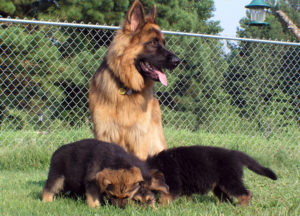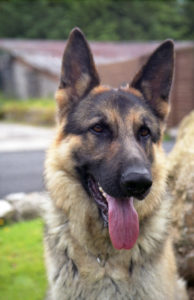To crate or not to crate? That is the question. Some owners don’t like to crate their dogs because they don’t like the idea of confining them. However, a crate can actually give your German Shepherd a sense of security and support. It’s almost like having a nice little safe haven where they can go when they feel stressed, anxious, or scared. If your German Shepherd is one who is particularly scared when thunder storms come through then giving them a safe space, like a crate, can help calm them down. And the best way to start is to come up with a German Shepherd Crate Training Schedule!

If you do decide to get your dog a crate, you’re going to need a German Shepherd crate training schedule. The point of this schedule is to gradually introduce this space to your German Shepherd so they can get used to it.
Don’t introduce your German Shepherd to the crate by locking them in there and then leaving for hours. Your German Shepherd likely won’t know what’s going on and become stressed which is going to create negative associations.
Over stressing your German Shepherd can also cause health problems and in some cases your German Shepherd may even find a way to hurt themselves physically.
Before we get into the German Shepherd crate training schedule, you’ll need to make sure you pick out the best crate for your German Shepherd. The crate should be big enough for your pup to stand comfortably and turn around in. There are three main types of crates available for dogs: plastic, fabric, and metal. We recommend getting a metal crate for your German Shepherd, just in case they try to chew their way out in the beginning of the training.
To make the crate more enjoyable, consider investing in a dog bed to put in there as well. This will help make the crate feel safe and comfortable. Now that you know what kind of crate to get, let’s get into the German Shepherd crate training schedule.
German Shepherd Crate Training Schedule

“Here boy! Look at your new crate!”
First Step:
Introduce your German Shepherd to the crate. Like we mentioned earlier, you can’t just shove your dog in there and expect things to go well. You’ll want to let your German Shepherd sniff the area and become familiar with it first. Place the crate in a high traffic area in the house, like the living room, office, or bedroom – anywhere that you spend a majority amount of time in. This will keep the dog from feeling isolated in the crate and creating that negative association. To really speed things up, put a soft blanket, towel or dog bed in the crate to give it a nice homey feel.
If your German Shepherd isn’t naturally curious to go into their crate, you can try prompting them by putting their favorite toys in there or even baiting them with some treats. Once your dog enters the crate and lays down don’t lock them in yet. Baby steps.
Dinner time!
Second step:
Start feeding your German Shepherd near the crate. With food being near the crate your GSD will start association positive feelings (dinner time) with the crate. If they naturally took to the crate, you’ll want to put their food bowl all the way in the back of the crate for this step. This way they’re completely in the crate while eating. Once they’re able to eat comfortably in the crate, close the crate door behind them while they’re eating.
The first time you do this you’ll need to open the crate immediately after your German Shepherd finishes their meal. Each time after that you’ll keep the crate closed for a few minutes after their done, and gradually start leaving them in the crate longer and longer as it becomes more successful.
If your German Shepherd was reluctant to the crate and is still hesitant about going in it, start by placing their food bowl near the crate. Then gradually put it in the crate, and then further in with each feeding. It may take longer for your German Shepherd to become comfortable with the crate, so be patient and don’t rush them.
If you find your pup starts whining when you close the door after feeding one of two things could have happened: one being that you left them in there for too long. Try to keep track of how long you’re leaving them in there and make sure they aren’t whining because it’s their potty time.
The other possibility is that your German Shepherd simply doesn’t want to be in there. In this case you cannot buckle under the pressure of those big brown eyes! Do not let them out until they stop whining, if you buckle they’ll whine whenever they want to be let out.
Lengthen the time spent in the crate
Third step: 
Once your German Shepherd is comfortable with the crate, you’ll want to start lengthening the times they spend in it and training them to know the command “kennel” or “crate.” You can teach this command just like you would teach them any other trick, say the command, have them do it, and reward them with a treat.
Once your dog is in the crate, sit with them (quietly) for a few minutes, then leave for about 5 minutes. Keep doing this and lengthen the time your dog spends in the crate with you out of site. Start with them being crated up with you in the room for 5 minutes, then with you out of the room for 5 minutes, then with you for 5 minutes and then without you for 10 minutes. Keep doing this and increasing the time away from each other by 5 minutes.
Once your German Shepherd is able to spend about half an hour in the crate silently when you’re in the other room, you can start letting them sleep in the crate during night time, or putting them in there for short times during the day. Always give your dog some lovin’ and praising after they’ve had a good session in the crate with lots of tummy rubs, kisses, and maybe some yummy treats.
Conclusion
Crate training your German Shepherd takes time, patience and a lot of treats. However, if you follow the 3-step German Shepherd crate training schedule listed above you can create a nice place for your dog to retreat to when they’re anxious, a comfortable place to sleep, or a relaxing area to spend their days while you’re at work.
Remember to take your German Shepherd outside before and after crate time to reduce the chance of any accidents from happening. If you plan on leaving your dog in the crate while you’re at work make sure they have access to food and water. You can also throw in a few of their favorite toys to help keep them company while you’re gone.
Have you crate trained your German Shepherd? Let us know how it went in the comments below!




One comment
Comments are closed.